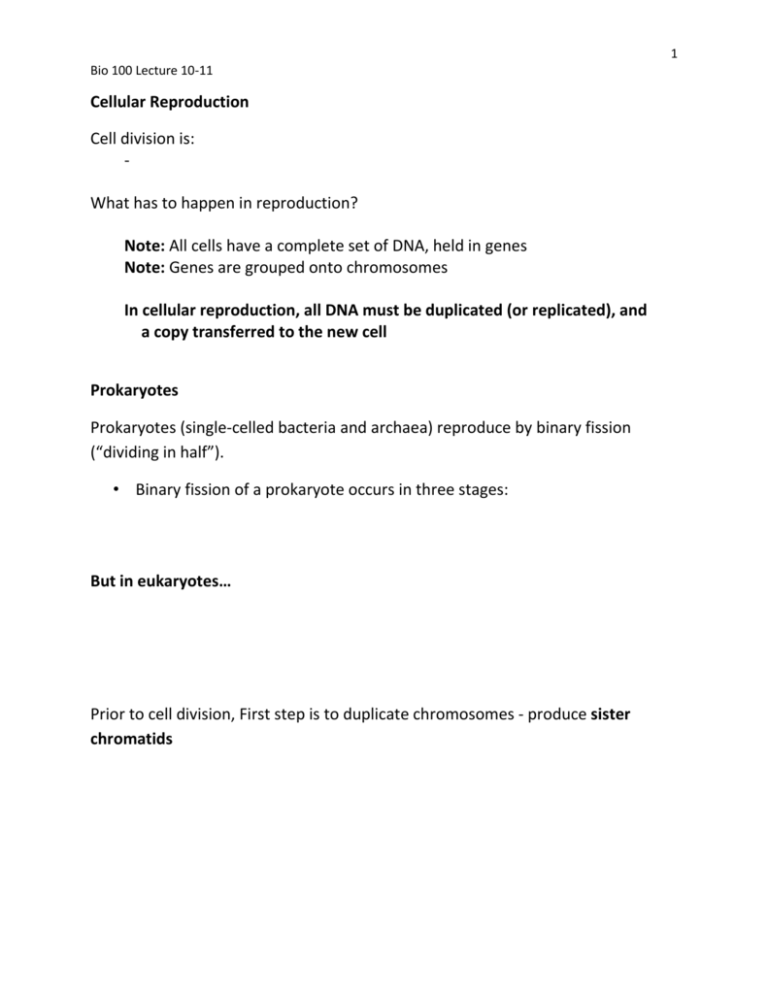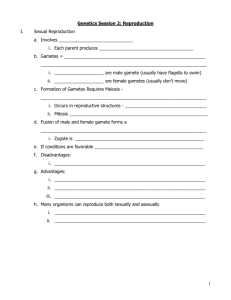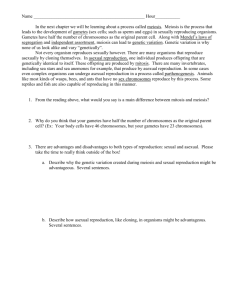Cellular reproduction
advertisement

1 Bio 100 Lecture 10-11 Cellular Reproduction Cell division is: What has to happen in reproduction? Note: All cells have a complete set of DNA, held in genes Note: Genes are grouped onto chromosomes In cellular reproduction, all DNA must be duplicated (or replicated), and a copy transferred to the new cell Prokaryotes Prokaryotes (single-celled bacteria and archaea) reproduce by binary fission (“dividing in half”). • Binary fission of a prokaryote occurs in three stages: But in eukaryotes… Prior to cell division, First step is to duplicate chromosomes - produce sister chromatids 2 Bio 100 Lecture 10-11 The Cell Cycle - Extends from when the cell is first formed from its parent cell to when it divides. Two Stages of the Cell Cycle: Interphase Mitotic Phase Interphase 1. Prophase 2. Prometaphase 3. Metaphase 4. Anaphase 5. Telophase (and Cytokinesis) 3 Bio 100 Lecture 10-11 Human cells have 26 chromosomes – 22 homologues pairs are autosomes Meiosis and Reproduction: Meiosis – the production of gametes Result of Meiosis: Gametes Law of independent assortment Separation of homologous chromosomes during meiosis can lead to genetic differences between gametes. 4 Bio 100 Lecture 10-11 Chromosomal Set Determination Chromosomal Abnormalities Trisomy 21 - Down syndrome Extra 21st chromosome, distinct look, short stature, possible heart defects, more common in older mothers Klinefelter Syndrome Extra X chromosome XXY - males with some female traits Turner Syndrome XO – female Chapter 9: Heredity and Genetics Gregor Mendel Mendel’s garden experiment Mendels Hypotheses: 5 Bio 100 Lecture 10-11 Mendel’s Laws A Pedigree – a family history Carrier – someone who has the recessive allele but it is not expressed. Just because a trait is dominant does not mean it is more common. Genetic Disorders Autosomal recessive Cystic Fibrosis Sickle Cell Anemia Tay-Sachs disease Autosomal dominant Dwarfism Huntingtons disease More complex inheritance patterns. 6 Bio 100 Lecture 10-11 Study Questions 1. Know mitosis and meiosis. 2. Define autosomal and gamete. 3. Know Mendelian genetics, his hypotheses and laws. 4. Be able to fill out a punnet square and a pedigree. 5. Define dominant and recessive. 6. Know other inheritance patterns.






